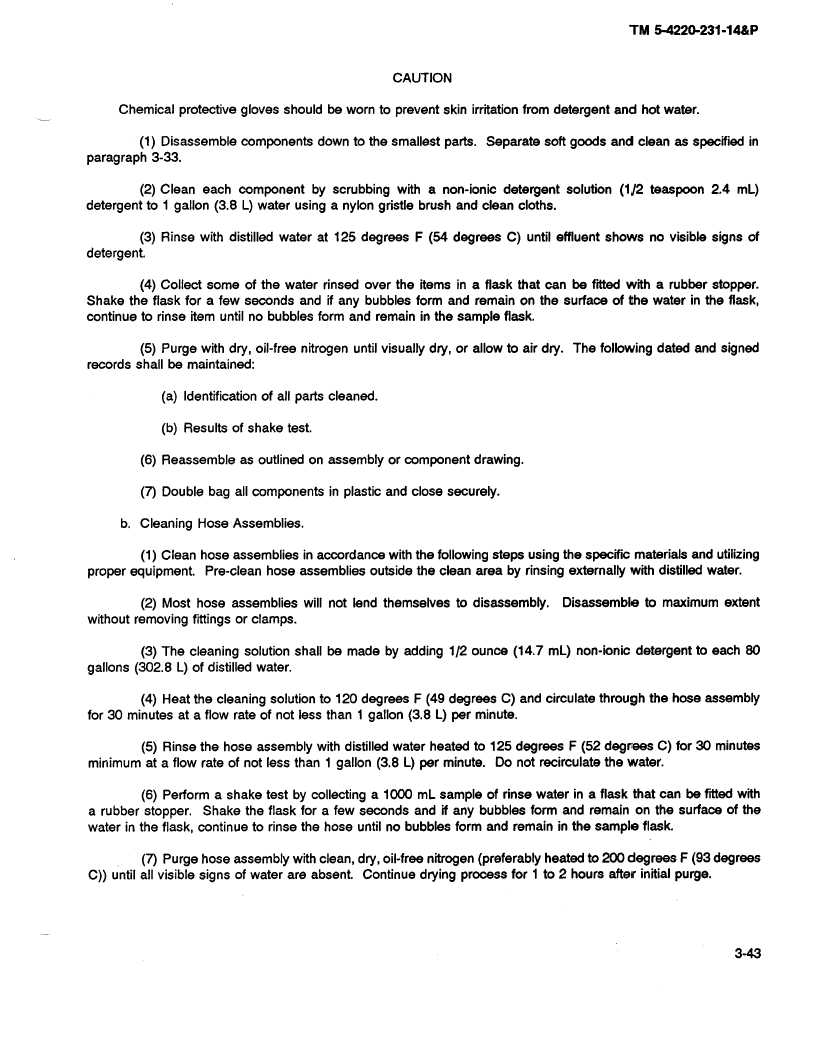TM 5-4220-231-14&P
CAUTION
Chemical
protective
gloves
should
be worn to prevent
skin irritation from detergent
and hot water.
(1) Disassemble
components
down to the smallest
parts.
Separate
soft goods
and clean
as specified
in
paragraph
3-33.
(2) Clean
each
component
by scrubbing
with a non-ionic
detergent
solution
(1/2 teaspoon
2.4 mL)
detergent
to 1 gallon (3.8 L) water using a nylon gristle brush and clean cloths.
(3) Rinse with distilled water at 125 degrees
F (54 degrees
C) until effluent shows
no visible signs of
detergent.
(4) Collect
some
of the water
rinsed
over the items in a flask that can be fitted with a rubber stopper.
Shake
the flask for a few seconds
and if any bubbles
form and remain on the surface
of the water
in the flask,
continue
to rinse item until no bubbles
form and remain
in the sample
flask.
(5) Purge
with dry, oil-free nitrogen
until visually dry, or allow to air dry. The following dated and signed
records
shall be maintained:
(a) Identification
of all parts cleaned.
(b) Results
of shake
test.
(6) Reassemble
as outlined
on assembly
or component
drawing.
(7) Double bag all components
in plastic and close securely.
b. Cleaning
Hose Assemblies.
(1) Clean hose assemblies
in accordance
with the following steps
using the specific
materials
and utilizing
proper equipment.
Pre-clean
hose assemblies
outside the clean area
by rinsing externally
with distilled water.
(2) Most hose
assemblies
will not lend themselves
to disassembly.
Disassemble
to maximum
extent
without
removing
fittings or clamps.
(3) The cleaning
solution
shall be made by adding
1/2 ounce
(14.7 mL) non-ionic
detergent
to each 80
gallons
(302.8 L) of distilled water.
(4) Heat the cleaning
solution to 120 degrees
F (49 degrees
C) and circulate
through
the hose assembly
for 30 minutes
at a flow rate of not less than 1 gallon (3.8 L) per minute.
(5) Rinse the hose assembly
with distilled water heated
to 125 degrees
F (52 degrees
C) for 30 minutes
minimum at a flow rate of not less than 1 gallon (3.8 L) per minute.
Do not recirculate
the water.
(6) Perform
a shake
test by collecting
a 1000 mL sample
of rinse water
in a flask that can be fitted with
a rubber stopper.
Shake
the flask for a few seconds
and if any bubbles
form and remain on the surface
of the
water in the flask, continue
to rinse the hose until no bubbles
form and remain
in the sample
flask.
(7) Purge hose assembly
with clean, dry, oil-free nitrogen (preferably
heated
to 200 degrees
F (93 degrees
C)) until all visible signs of water are absent.
Continue
drying process
for 1 to 2 hours after initial purge.
3-43


